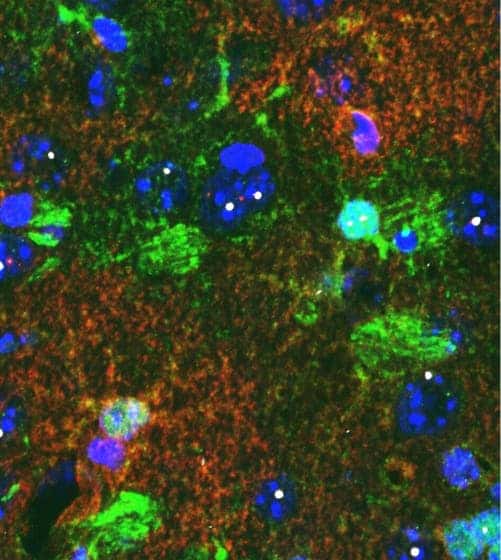
Brain tissue from a mouse shows star-shaped astrocytes (green). Cells (blue) containing mutant protein (white) display lower levels of a potassium-regulating protein (red). Photo: UCLA
Approximately one in 20,000 Americans suffer from Huntington’s disease, a devastating neurodegenerative affliction that gradually deprives patients of their ability to walk, speak, swallow, breathe and think clearly. Like other similar diseases, like Alzheimer’s, there isn’t any cure, but scientists at University of California, Los Angeles (UCLA) may have discovered a way to tackle it by looking elsewhere than other researchers. Namely, by boosting the potassium intake ability of a specific cell in the brain, the UCLA researchers improved walking and prolonged survival in a mouse model of Huntington’s disease.
Huntington’s disease is passed from parent to child through a mutation in the huntingtin gene, namely a genetic defect on chromosome 4. The defect causes a part of DNA, called a CAG repeat, to occur many more times than it is supposed to. Normally, this section of DNA is repeated 10 to 28 times. But in persons with Huntington’s disease, it is repeated 36 to 120 times. As the gene is passed down through families, the number of repeats tend to get larger. The larger the number of repeats, the greater your chance of developing symptoms at an earlier age. Therefore, as the disease is passed along in families, symptoms develop at younger and younger ages.
After onset, the disease gradually kills neurons causing the dreaded symptoms, while patients with aggressive cases can die in as little as 10 years. Most research has concentrated on neurons and their mechanics, looking on how these interact and how these genetic malfunctions cause Huntington’s. The UCLA researchers, however, took an alternate route and looked at what role astrocytes — large, star-shaped cells found in the brain and spinal cord — play in Huntington’s.
The stellar nebula in the brain
Astrocytes appear in almost equal number as neurons and enable the latter to signal each other by maintaining an optimal chemical environment outside the cells. The scientists used two mouse models to explore whether astrocytes behave differently during Huntington’s disease: the first model studied an aggressive and early-onset type of Huntington’s; the second a slow-developing version.
In both models, astrocytes with the mutant gene showed a measurable drop in Kir4.1, a protein that allows the astrocyte to take in potassium through the cell membrane. This caused too much potassium to accumulate around the cell, disrupting the delicate chemical balance and causing neurons to grow oversensitive and fire too easily, disrupting nerve-cell function and ultimately the body’s ability to move properly. Ultimately this may be what causes the jerky motions common to Huntington’s disease.
To test if this hypothesis is correct, the researchers sought to find what would happen if they artificially increased Kir4.1 levels inside the astrocytes. The results speak for themselves.
“Boosting Kir4.1 in the astrocytes improved the mice’s ability to walk properly,” said Baljit Khakh, a UCLA professor of physiology and neurobiology. “We were surprised to see the length and width of the mouse’s stride return to more normal levels. This was an unexpected discovery.”
“Our work breaks new ground by showing that disrupting astrocyte function leads to the disruption of neuron function in a mouse model of Huntington’s disease,” said Michael Sofroniew, a UCLA professor of neurobiology. “Our findings suggest that therapeutic targets exist for the disorder beyond neurons.”
“We’re really excited that astrocytes can potentially be exploited for new drug treatments,” said Khakh. “Astrocyte dysfunction also may be involved in other neurological diseases beyond Huntington’s.”










